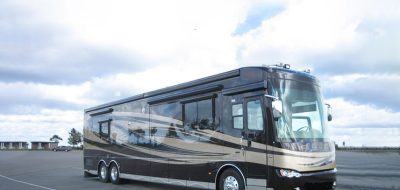 The weight of your RV is important. Weight affects your safety and the safety of others on the road plus the economy and operation of your RV. Weight is also regulated—that is, you must comply with the law wherever you might be driving. While it is impossible to be too underweight, it is dangerous and illegal to be overweight.
The weight of your RV is important. Weight affects your safety and the safety of others on the road plus the economy and operation of your RV. Weight is also regulated—that is, you must comply with the law wherever you might be driving. While it is impossible to be too underweight, it is dangerous and illegal to be overweight.
Additionally, all this weight rides on your tires. Therefore, your tires are of the utmost importance since they are the single point of contact between you (or your trailer) and the highway at all speeds. Take good care of your tires.
Learning How Much Weight You Can Carry
All recent RVs must have a label showing the weight capacity of the rig in both empty (unloaded) and maximum weight configurations. This labeling complies with the Recreational Vehicle Industry Association (RVIA) and/or the Federal Government Standards. Locate your label and become familiar with the information. It is often found on the inside of a cabinet or closet and is usually the size of a sheet of paper.
The abbreviations used on the label are fully explained. It is important to recognize that these labels show the estimated carrying capacity of this RV. If the RV was manufactured prior to September 2000, the term Net Carrying Capacity (NCC) was used. NCC is the difference between Gross Vehicle Weight Rating (GVWR) and the Unloaded Vehicle Weight (UVW) and does not consider the weight of the water, propane, or people you might be carrying. You, the owner, have to remember to factor this in.
In September 2000, the RVIA adopted a new term called Cargo Carrying Capacity (CCC). The CCC is the difference between Gross Vehicle Weight Rating (GVWR) and the Unloaded Vehicle Weight (UVW) and then subtracts the weight of a full tank of water including water heater, full tank of propane, and the weight of the passengers. The Sleeping Capacity Weight Rating (SCWR) is determined by multiplying 154 pounds (70 kilograms) by the number of sleeping positions. The remaining “unused” weight—the Cargo Carrying Capacity—is the amount of “stuff” you can safely carry before exceeding the manufacturer’s Gross Vehicle Weight Rating (GVWR).
The CCC does not account for any accessories added to your RV after it was manufactured. The weight of accessories must be deducted from the CCC to determine the actual weight of “stuff” you can pack and take with you. This includes the array of things such as canned goods, clothing, tools, cleaning supplies, dishes, and the coffee pot, to name just a few. Therefore, the CCC directly affects the amount (in weight) of the personal items you can carry.
The total weight of the RV must not exceed its GVWR nor should any axle exceed its particular weight rating. Axles and individual wheel positions can be weighed separately. Each wheel position should not exceed the inflated tire’s rated capacity. It has been estimated that over half of all RVs exceed their rated capacity in at least one wheel position.
It is not unusual for one side of an axle to carry more weight than another. For example, if the refrigerator, stove, microwave oven, and sink are all on one side, it is possible that this “kitchen” (or galley, as it is called) side of the coach will weigh more than the opposite side. The RV manufacturer may have compensated for this imbalance by providing more carrying space on the opposite side. Doing so allows you to load more weight on the “under loaded” side. Knowing this implies that the location of what you carry is also important.
Load your RV as you would for normal travel. Locate a public weigh-scale (most commonly found at truck stops). Have your RV and toad, or your tow vehicle and trailer weighed axle-by-axle. The following table will simplify what to weigh and why.
Ideally, it is best to have it weighed wheel by wheel, to determine how much remaining capacity you may have, and where it is located. This process will verify if you need to rearrange what you are carrying to better balance the RV.
However, locating facilities to weigh each wheel position is more difficult. Sometimes you can move slightly off the truck scale in such a way that you can obtain individual wheel weights. Often, this service is provided at RV rallies and shows and the weighing may be part of a safety seminar. There are private companies providing weighing services at these events and in campgrounds as well. All will physically weigh your coach or trailer by individual wheel position.
Once you know the weight on each tire position, you can easily determine if you exceed any specification—tire, axle, or vehicle—and make adjustments accordingly.
Learning About Weight and Your RV Tires
RV manufacturers must certify the tires and tire pressures required to support the vehicle. On drivable RVs, there will be a Federal (or Canadian) Motor Vehicle Safety Standards (FMVSS / CMVSS) compliance label (data plate) in the area of the driver’s seat. (The label shows the Gross Vehicle Weight Rating (GVWR), the individual Gross Axle Weight Ratings (GAWR), and the Gross Combined Weight Rating (GCWR) that was determined by the final body-builder or manufacturer. The manufacturer will certify the capacity of the vehicle as it was built with the tires and tire pressures required to support this capacity and this will be shown on the label.
Tires on motorhomes are “truck” tires although many are specially manufactured for RVs. The RV tires often have high weight-carrying capacities and a UV protectant in the rubber. Ratings marked on their sidewalls show the maximum carrying capacity based on a maximum tire pressure for both single- and dual-wheel configurations. If you should lower the air pressure, you will reduce the capacity of the tire and the amount of load-carrying capacity of the RV.
You should contact the tire manufacturer and obtain the tire load charts or booklet that specifies the weight carrying capacity for your tires at various tire pressures. It is strongly recommended that you do this. Their information will also include how to properly check your tire pressure (always when cold), how to safely add air (remember, 105 pounds of pressure in a tire casing is high pressure and deadly if the tire blows), and how to determine how old the tire is (the DOT Code).
Always keep the same pressure on each side of an axle. Determine this specified pressure by using the tire pressure required to support the weight on the most heavily loaded wheel position.
You may hear talk among RVers about adding some extra air for safety. Tire manufacturers used to recommend increasing the tire pressure by ten percent (10%) above the amount required to carry the load you determined by the weighing process. Theoretically, this provided a margin of safety and allowed for the natural depletion of air pressure as time passed. However, that 10% recommendation is now built into the tire ratings for the RV type tires. There’s no need to add more.
One of the major factors in tire wear and failure is under inflation. It is imperative that you know the weight of your RV and how much air to put in your tires. Therefore, to be safe, comply with the laws, and save money, know your RV weight and tire pressure. Load your RV carefully and knowledgeably. Plus, make sure to frequently check your tire pressure when cold at the start of each day. Use a good quality, accurate tire pressure gauge.
What and Why to Weigh (pdf)
All the Stuff You Need to Know About RVing by Ronald Jones and Robert Lowe, is available at www.rvstuff.org or call 800-262-3060 (USA) or www.rv-partsplus.com or 877-266-5398 (Canada)






ken dixon
I read the artical about weight i have a pop up camper i pull it with a chevy colorado 5cyl engine, ( it does a great job great fuel mileage ) i always weigh it at a seed company or grain elevator always for free open 24/7 and can be found in many rural areas some elevators may charge, esp in fall during harvest when they very busy, have a safe happy trip camping is great fo all ken